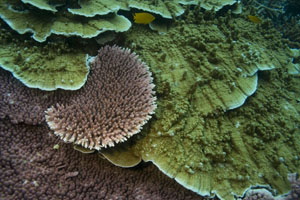 |
| dense and healthy coral coverage close to Renggis Island |
July 4 – 11th, 2008
This reef was also studied by PCRF in 2001 and 2006. Please refer to the links at the top of each page for comparative data sets.
Fringing.
No disease was observed on this reef during the course of the study dives or any other dives.
Visibility was highly variable over the study period. Horizontal visibility ranged from 43' to 82' and vertical visibility from 45' to 53'. Measurements were taken using a Secchi disk.
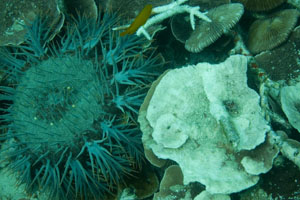 |
| damage by crown of thorns |
Since 2001, we have observed reasonably high numbers of crown of thorns seastars on this reef. In 2008, the level of predation is still significant and overwhelming on some areas of the reef, particularly on the northern and eastern sides of Renggis Island. Areas of foliaceous Montipora spp. and branching Acropora spp. colonies are particularly prone to predation by these corallivorous seastars. The crown of thorns is also visible on other areas around the reef. Cleanups have been conducted in the past to remove excessive numbers of these invertebrates. We were unable to find any information regarding recent cleanups.
For general information regarding Tioman's geography, please refer to the 2006 Reef Report.
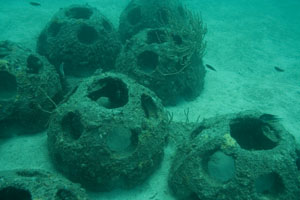 |
| the Reefballs on the northeast of Renggis |
With regards to recent development on the west coast of Tioman, the construction of a marina for yachts, a small boat canal running behind the ferry jetty and a beach just to the north of the jetty have been completed. The road running across the island from Tekek to Juara is still under construction. Further work continues at the Marine Park centre where a seawall and beach are under construction. All of this development is potentially taking its toll on Renggis reef. Please see the Threats to the Reef section at the bottom of this page for further discussion. The plans for an airport built out into the sea are still under discussion.
The Reefball project around Renggis continues but there are still few signs of recruitment of scleractinian corals on these cement structures. It would appear that they become smothered in sediment, prohibiting settlement of corals.
For a full description of the topography of the reef around Renggis, please refer to the 2006 Reef Report.
Renggis Reef was heavily affected in the 1980s and 1990s, predominantly by destructive fishing methods. It was gazetted as part of the Pulau Tioman Marine Park in 1994. By the time of our first study here in 2001, we were told by local residents that the reef around Renggis had begun to show signs of a very healthy recovery. By 2006, this recovery was very evident from the flourishing hard coral cover, especially close to the island itself. However, it would appear in 2008 that the state of health of the reef has reversed towards decline again, with health less than 40% and threat above 50%.
Results from our Vitareef surveys over the course of the last seven years corroborate this. In 2001, the overall health of the shallow and deep zones was 46.20% and 41.13%. In 2006, these figures were respectively 65.79% and 60.42%. In 2008, these figures were respectively 39.43% and 38.13%. In 2001, the level of threat in the shallow and deep zones was 53.30% and 53.60%. In 2006, these figures were respectively 25.77% and 31.88%. In 2008, these figures were respectively 55.62% and 56.40%.
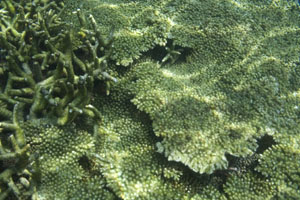 |
| dead Acropora spp. table |
One significant change in observations between 2001 and 2008 is the level of bleaching recorded. It is possible that in 2001, corals showing white were scored in the Vitareef methodology as bleached areas, whereas in fact they may actually have been corals predated on by crown of thorns seastars. No bleaching was scored in 2008 whereas in 2001, 18.10% of corals in the shallow zone and 28.17% of corals in the deep zone were scored as being afflicted by bleaching.
Code 5 represents damage to tissue and skeleton and code 7 represents damage to tissue only. In 2001, tissue damage affected 9.80% of corals in the shallow zone and 5.26% of corals in the deep zone. In 2008, these figures were respectively 17.03% and 13.33%. Incidence of crown of thorns seastars does not appear to have significantly increased in this seven year period, although incidence of corallivorous snails which predate mainly on the lower areas of branching Acropora spp. colonies appears to have significantly increased.
Overgrowth by filamentous algae has increased significantly since 2001. In 2001, 12.60% of colonies in the shallow zone and 12.78% of colonies in the deep zone were affected by overgrowth by filamentous algae. In 2008, these figures were respectively 27.52% and 29.86%.
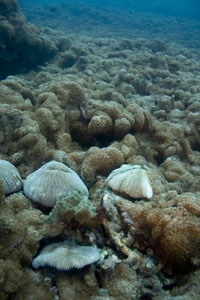 |
| Fungia spp. in a carpet of corallimorphs |
Overgrowth by invertebrates has changed very little in the shallow zone. Code 19 (overgrowth by invertebrates) was scored for 26.80% of colonies in 2001 and 26.01% of colonies in 2008. However, there is a significant change noted in the deep zone. In 2001, overgrowth by invertebrates afflicted 35.19% and in 2008, this number decreased to 22.55%.
Still images taken along transect lines in 2008 were analysed using Point Count. These showed a total live coral cover of 40.40% in the shallow zone and 66.47% in the deep zone. Total dead coral cover was 23.54% in the shallow zone and 13.19% in the deep zone. These transects were laid out using GPS coordinates from transects conducted in 2001. We will analyse the video imagery taken in 2001 for comparison. Both of the deep zone transects fell in areas of dense hard coral cover (predominantly Echinopora spp., Acropora spp., and Porites rus).
The healthiest and most diverse areas of hard coral cover to be found at Renggis are closest to the rocks of the island, especially on the northern side.
In 2001, two observers recorded fish observations at four sites around the Renggis Reef and logged their observations as separate data sheets. The total number of fish species observed between them was 134. In 2006, one observer recorded fish observations at two sites. The total number of fish species observed was 73. In 2008, one observer recorded fish observations at four sites. The total number of fish species observed was 104. The same observer counted fish species in 2001 and 2008. In 2001, she counted 97 species and in 2008 she counted 104, both over four survey dives.
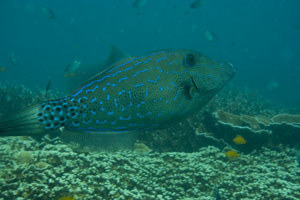 |
| scrawled filefish Aluterus scriptus |
One of the most obvious changes was the lack of titan triggerfish, Balistoides viridescens. In 2001, three of the four fish surveys included observation of an individual. In 2006 and 2008, none were sighted on the transects, nor incidental observations made during the course of other dives. This fish is a predator of the crown of thorns and its absence only enhances the predation by the seastar on coral tissue.
Another possible shift in the fish ecosystem was the lack of observation since 2001 of the black tip reef sharks, Carcharhinus melanopterus, a species regularly sighted in 2001 on the south side of Renggis Island. It is possible that its presence on the reef is seasonal and local dive operators claimed to have sighted them earlier this year.
The giant clam Tridacna gigas is believed to be extinct within the Tioman Marine Park through overharvesting. However, we observed several other species of clam on the reef at Renggis.
Sea cucumbers are highly valued in Malaysia, some for food, especially Stichopus chloronotus and some for medicinal value, especially Stichopus variegates and Stichopus horrens. The former species was observed during a documentation dive at Renggis. High numbers of Holothuria atra were observed at Renggis.
Lobsters sell for US$20-30 per kg in Malaysia. None were observed on Renggis Reef.
Several species of sponge (unidentified) are present in high density on certain areas of the reef, and seem prevalent to encrust branching Acropora spp. colonies after predation by crown of thorns seastars.
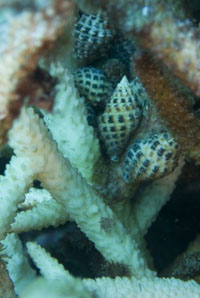 |
| corallivorous snails on Acropora sp. |
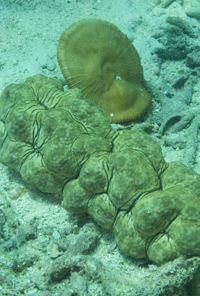 |
| sea cucumber Stichopus variegates |
Anemones are still present in high numbers all over the reef. Small corallimorphs are also very visible in several areas where they have clustered to form fields, also in between the branches of many branching coral species, especially Acropora spp. and Porites spp.
Corallivorous snails were very obvious on several large areas of branching Acropora spp. on the north western side of Renggis. Lower areas of the branches bore the scars of very recent predation with fresh white skeleton exposed, and some areas of the branching colonies contained dense clusters of hundreds of these snails. These snails have caused large-scale destruction on other reefs in the Indo-Pacific when populations reach outbreak level.
No marine mammals were sighted in the area during the course of our stay here.
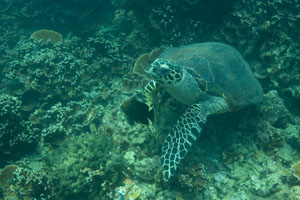 |
| female hawksbill turtle sighted at Renggis |
Hawksbill turtles were frequently sighted around Renggis. A project on the west side of Tioman Island, at Juara, is encouraging a shift from harvesting turtle eggs for sale to gathering the eggs for incubation in a hatchery on the south end of Juara beach. Licences are still issued for legal collection of turtle eggs for sale as food. Currently, eggs are bought from these sanctioned egg collectors for safe hatching. Beaches collected from are on the west and south side of Tioman, with plans to expand collection to all beaches on Tioman. When the eggs hatch, the hatchlings are brought by boat back to the beach on which they were laid for release. This is a long-term project with two main goals - to increase the chances of turtle survival although the forecasts are rather grim. From 10,000 eggs gathered and hatched in this way, only one turtle is expected to survive to an age of returning to the nesting beach to lay eggs. The second goal is education of the local culture to stop harvesting turtle eggs.
Reports are that only one leatherback turtle has recently nested in all of Malaysian waters, in other words that this species may now be extinct from this area.
There are many threats which appear to be adversely affecting the reef around Renggis Island. Some of these are technically mitigated by the reef lying within the Pulau Tioman Marine Park, however, continued increase of these threats could reach a critical level for the future health and vitality of this reef which had been recovering so well from a previous history of destructive fishing practices.
PCRF has studied the reef at Renggis three times now - in 2001, 2006 and 2008. The 2001 and 2008 studies were both conducted during the season in which Renggis is protected from the prevailing winds by the height of Tioman. The 2006 study was conducted during the north west monsoon when heavy rainfall and rough seas made access to all parts of the reef more difficult. As a result, Vitareef data was collected over a wider area on the reef in 2008 compared to 2006, incorporating more data from the south of Renggis Island which is a less healthy and diverse area of the reef system. This may have influenced Vitareef results to an extent.
Increased tourism on Tioman, attracted especially by the recent development and expanded tourist programme on the island, is clearly having and will continue to have a detrimental effect on Renggis. In the period from July 2007 to July 2008, more than 6,000 visitors signed the registration book at the Marine Park Centre. However, this number only represents visitors to the centre and does not include tourists who fly to Tioman and buy their Marine Park ticket at the airport on arrival, or those who arrive by ferry from Mersing on peninsular Malaysia. We were unable to determine the total number of tourists arriving to Tioman, but it is clear that the number is increasing rapidly.
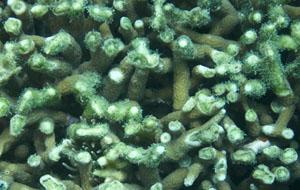 |
| broken tips of coral, now covered in filamentous algae |
Increased visitors to Tioman results in increased boat traffic, snorkellers and divers on its surrounding coral reefs, especially Renggis since it is so accessible from Tioman. In particular, the Berjaya Resort which lies directly to the east of Renggis Island underwent a major expansion during 2006. It now has 361 rooms with a potential capacity of about 1,000 guests during high season. Many tourists from Berjaya snorkel on Renggis because it is so close to the resort. Close to the buoys where tourist boats tie up at Renggis, there are large and very obvious areas of severe damage to the reef, where snorkellers are standing on the corals, breaking tips of branching corals and smashing plate corals. These areas are now dead and smothered with filamentous algae.
Two polluting factors from such a large operation so close to the Renggis reef are waste water and runoff. We were unable to find any information regarding sewage treatment at Berjaya. There are 100 acres of golf course at the resort and these are fertilised, predominantly with nitrogen-based fertilisers. This will only increase algal overgrowth issues on Renggis.
The beach at Berjaya is eroding, so much so that sand bags and cement blocks under the beach are showing through and some trees have fallen down. This could cause increased sedimenation issues on the reef.
Increased boat traffic to Renggis is another problem. There are approximately four diving boats moving on and off the mooring buoys every hour during daylight hours. Safety for snorkellers and divers in the water is one issue and possible pollution another. Turtles, which we sighted frequently around Renggis, are very prone to damage by small boat propellors. Propositions to put cages around all boat propellors have not been taken up yet. Pollution from small boat fuel is another potential issue. Mooring buoys have been established here since at least 2001 to minimise damage from boats anchoring although during our stay in 2008, one yacht anchored on the north side of Renggis reef. They were moved after several days by local authorities. Jet skis are technically prohibited within the two nautical mile limit around Tioman, Renggis and the seven other islands of the Pulau Tioman Marine Park, however, this is not enforced and jetskis run out of Berjaya Resort frequently.
The construction and development that began in earnest in 2006, centred around Tekek, the main town on the west side of Tioman continues. The satellite image shows the route of runoff from Tekek flowing southwards, which agrees with our observations of a predominantly north to south current. In other words, sediment and other detrimental materials are carried from Tekek and its surroundings towards Renggis. Construction continues to build a road from Tekek on Tioman's west side to Juara on its east side, plus a road running along the west coast of Tioman from Tekek southwards. The roads run accross rainforest mountains (upwards to 1,000 metres high). Clay silt is thus washed directly into the sea.
 |
| fish caught in the trap at Tulai |
The Pulau Tioman Marine Park is clearly in need of additional support to carry out the original aims intended. For example, while at Pulau Tulai, another island gazetted at the same time as Tioman and Renggis, we found numerous fish traps in shallow waters were coral reef fish - both ornamental and food-fish - were trapped in chicken-wire basket structures placed on the reef. We also found fishing line on the reef at Renggis. In theory, no fishing of any form is allowed within two miles of the islands, therefore the original intentions of protection are not being fulfilled.
In terms of biological predation on living coral cover, the crown of thorns continues to be a problem on this reef and on other reefs in the area. SV Infinity spent a week at Pulau Tulai, about six nautical miles north west of Tioman. Here crown of thorns had reached a high level of infestation and most of the shallow zone of reef inside the western bay of this island was devastated.
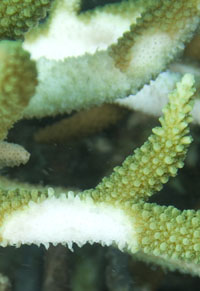 |
| fresh crown of thorns damage |
Crown of thorns is a problem in general on the reefs of the eastern islands of Malaysia. Continued vigilance and effective cleanups must be continued to keep this predator at bay. Another corallivorous predator increasing in presence at Renggis is the snail, thought to be Drupella spp. Large clusters of these were found in certain parts of the reef at Renggis. These have caused massive die-offs of hard coral cover on other reefs in the past.
In conclusion, Renggis reef is an important reef to continue to monitor, because it lies at the heart of a potential conflict between an expanding tourist industry and the intent to protect the waters and reefs of the area.
With thanks to the Pulau Tioman Marine Park for their continued efforts in preserving Renggis and the other reefs of the area, to local dive operators for their efforts in crown of thorns cleanups, and to John Amos and his collaborators for the turtle conservation project at Juara.
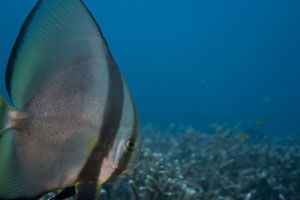 |